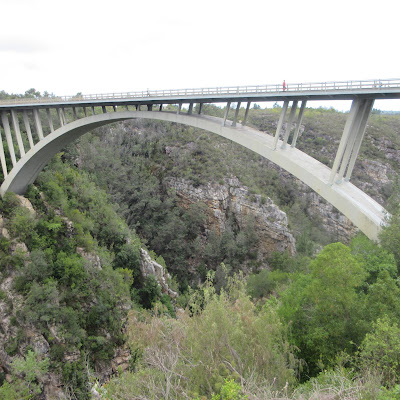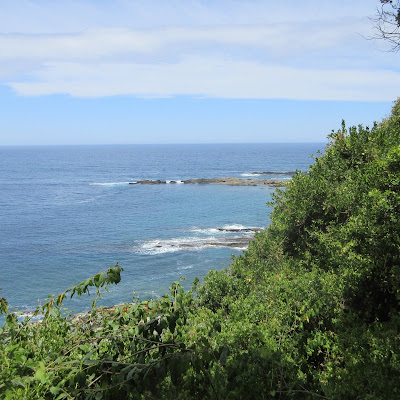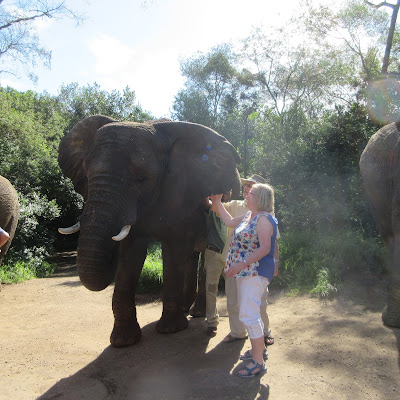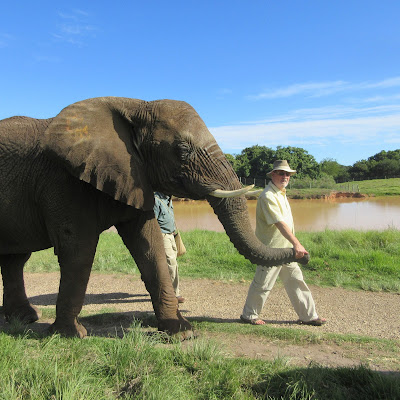Our new guide, a white South African called Tracy, joined us outside the Radisson Blu. Once on board we were introduced to Ashley our driver. The scenery on the way to Tsitsikamma National Park was lovely.
This part of South Africa (from the south east Cape to the West Cape) is rich in native fynbos vegetation. It looks like scrubby plants and bushes. The King Protea, South Africa's national flower, is the most famous species of fynbos as well as ericas and reeds. It is because of the diversity of the vegetation that this area is called The Garden Route.
The countryside in South Africa at this time of year is full of agapanthus in shades of blue and purple.
Tracey told us that this bridge is locally known as suicide bridge because of the number of deaths from here.
Jeffrey's Bay.
Shortly after this Ashley hit a bird - a blue humped guinea fowl reputed to run very fast but, in this instance, in the wrong place at the wrong time!
We arrived in Tsitsikamma National Park (Tsitsikamma means Place of Sparkling Water) where we were going to take a walk along the suspension bridge across the Storms River mouth gorge. What Tracey neglected to tell us until we began the walk was that that involved a round trip up and down countless steps that took an hour and a half.
We stopped to admire the Rock Hyrax or Rock Badger , also called the Cape Hyrax, but commonly referred to in South Africa as a Dassie. Tracey described them as hamsters on steroids! Their closest living relative is the elephant.
This is a very popular area for water sports.
Views as we made our way up (and down at times) to the gorge.
The Suspension Bridge. Charlotte said, "I'm nae goin over tha!"
Looks like I was! It would have been a waste of a strenuous walk!!
And Tracey also neglected to tell us that, to avoid back-tracking, we had 2 further suspension bridges to cross. Needless to say Jim amused himself by shaking the bridge while we were on it!
"No dae that you goon!"
Bridges crossed and a friendly tourist took some photos of all 3 of us when we finally made up after the adventures on the bridges!
We also saw 2 whales from here but too far away to photo.
Jim was fascinated by the dassies.
Seemingly they can collapse their rib cage to slip into narrow spots.
We had finished the walk in under an hour so we were waiting on the others.
According to Tracey we would normally have lunched at thge restaurant near the beach but there had been a fire on Friday and the place was gutted - in fact it was still smouldering when we passed it on our way to the suspension bridge. It is a devastating thing for the owners and staff. It was just the start of high season and now there would be no wages and, even worse for the staff, no tips on which they depend to feed their families! Lunch was at the Tsitsikamma Village Inn which was decorated with wild life.
Fountain at the entrance with Tracey and Fionnuala in the background.
Our Doc Martin (married to Triona Griffin from Sessiaghoneill Ballybofey) in the foreground - intent on the menu. To the right Marilyn (likewise). Centre back - John. Left - Derek.
The Tsitsikamma Mountain range.
After lunch Jim wandered about an d came on a 60's Diner filled with memorabilia of Marilyn Monroe, Elvis and the Beatles.
Meanwhile I was taking a few photos of the grounds. That's Ashley from behind.
I really liked the Tsitsikamma range of mountains.
The Tsitsikamma Range has multiple peaks. Very pretty!
We passed over the bridge which has the world's highest bungee jump. It was hard to get a proper picture.
I wouldn't fancy jumping towards this even if attached!
We had now crossed into The Western Cape. South Africa has 9 provinces - Western Cape, Eastern Cape, Northern Cape, North West, Free State, Kwazulu Natal, Gauteng, Limpopo and Mpumalanga. There are 11 official languages. 5.6 million live in the Western Cape where the main language is Afrikaans , then isiXhosa, and then English. In Parliament they generally speak English. Jacob Zuma is the President of South Africa but it sounds like no one pays any attention to him. Western Cape has the majority of coloured people. South Africa is called the Rainbow Nation because of its white, black coloured and Indian peoples.
At this stage there was a slight change in the schedule as Tracey had booked an optional Cat Sanctuary for the following day. Because of this we were going to The Crags Elephant Sanctuary before we booked into our overnight accommodation.
The Crags African Elephant Sanctuary offers an interactive elephant experience. Guides bring the guests through the sanctuary and offer insight into African elephants. The elephants in the sanctuary would not have survived in the wild as their injuries would have caused them to be expelled from the herd.
Charlotte being introduced to Amarula, the leader of the elephant group. Amarula had her trunk caught in a wild animal trap when she was very young and, as a result, had lost a most vital part - the grasping part which, in fact, is two fingers. An African elephant is able to grasp things by pinching the opposing tips of the trunk something the Asian elephant can't do as it doesn't have fingers.
I walked with Tandi. Tandi still has her fingers so I had to cup my hand backwards and Tandi held my hand with her trunk. I was a little apprehensive at first but then I got into my stride!
I must admit though it was a bit like putting your fingers up someone's nose. The breathing and slimy excretions were a little off-putting!
Tandi was born with no tusks and so was no longer accepted by the herd. She had to be taught other ways of foraging, digging and moving things out of the way.
Triona was getting a bit amorous with Jabu.
When we reached the wooded area the trainers had the elephants do some tricks - a bit like in a circus. I was a bit uncomfortable with that. The trainers assured us that the elephants were not expected to do anything they would not do in nature.
Jabu blew for her trick. There was a bit of spray! An elephant trunk can hold 10-12 litres of water when growing up. Baby elephants are not very adept at using their trunks and they often walk on them. Luckily for human children they don't have to worry about tripping over their noses, only their feet!
And Tandi shook her ears which is what elephants do as a warning sign.
Next came close inspection visually and tactile of the elephants. Thick, hard and wrinkly skin.
Big ears but skin very thin on the back of the ears.
Skin thick and wrinkly around the backside.
Jim not too keen on tickling its tummy!
Knobbly knees!
Tail thin and tipped by very coarse wire-like hairs. Wouldn't like to be whipped by that!
Elephants have toenails rather than hooves.
Inspecting mouth and tongue. Lovely big tongue. Seemingly they like their tongues being stroked. It was bad enough having my fingers in its nose so didn't touch the tongue! Anyway, it might have thought I was a piece of food!
Elephant declared in good condition by the Kings!
Jim walking with Jabu. Jabu also lost her fingers in a childhood accident so Jim had just to hold the trunk and didn't have the unpleasantness I had!
Charlotte feeding one of the elephants which does not have fingers. Both Amarula and Jabu have been taught how to cup their trunks in order to transport food into their mouths.
I don't think I would make a good elephant feeder!
Two bull elephants that have not been conditioned to humans as yet.
And back to the coach again where we got stuck behind this for quite a while. It's a Bakkie (Bucky) which is a two-seater light vehicle with an open rear cargo area. It is used to transport an impossible number of workers who stare back at you making you feel guilty that you are better off than them. Unemployment in South Africa is 27%. Since the end of apartheid it is easier for blacks to get jobs but more difficult for whites and indians.
We also passed the township of Plett (informal settlement) where the shacks are wood rather than tin. Practically every shack has satellite tv . They have no electricity but, as Tracey said, they relocate the electricity!
We arrived at our next overnight destination - Hunter's Country House at Plettenberg Bay. This is a really beautiful place with beautifully landscaped gardens and nooks for relaxing in. We were welcomed in the sitting room with iced tea and a description of the dinner menu. The guests stay in individual thatched cottages (except us - we were in the cottage with a tin roof. I think that might have been a message!). The sitting room/lounge is full of old furniture and the honesty (when the staff are around) bar is on the sideboard. There is a mezzanine library accessed by stairs from the sitting room. There is a display of three wines that suit the dinner menu of the evening. There are 2 private dining room - one of which Christopher's family use in case anyone has rare meat which causes Christopher to faint - and a larger one for our group
This is an outside covered area with piped music.
Breakfast room.
One of the private dining rooms.
The food was great here. We started with an amuse bouche of goat's cheese and salmon with horseradish and strawberry sauce. I chose carpaccio of venison as a starter. Then there was an apple sorbet. Main course for me was rack of lamb, mash and carrots. I don't remember what was for dessert as I did not have any.
Our room was really comfortable and well equipped even if we didn't have a thatched roof. It was called Rose Cottage.









































































































No comments:
Post a Comment